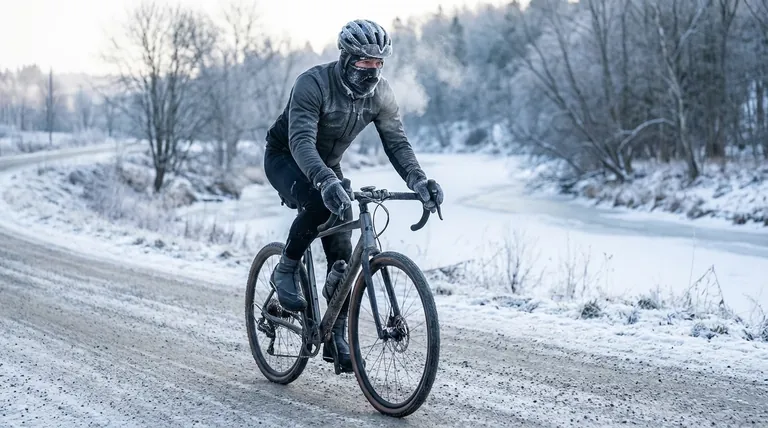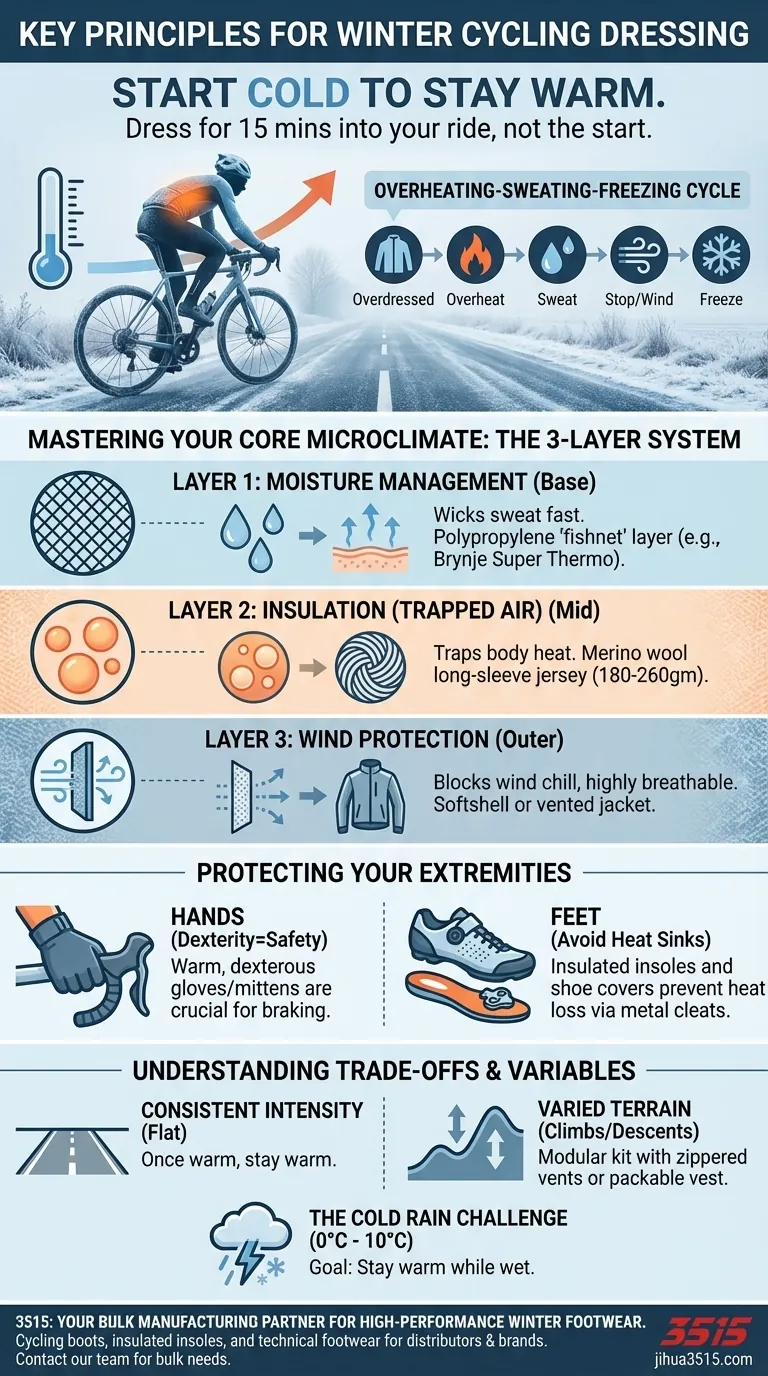The single most important rule of winter cycling is to dress for 15 minutes into your ride, not for the moment you step out the door. The goal is to feel slightly cool or even cold before you start pedaling. Your body is a powerful furnace, and overdressing at the start will lead to a cycle of sweating and chilling that can ruin your ride and even become dangerous.
The secret to winter cycling comfort is not piling on insulation, but creating a personal microclimate. This is achieved through a technical layering system designed to aggressively manage moisture, trap insulating air, and block wind, all while protecting your extremities by keeping your core warm.

The Foundational Principle: Start Cold to Stay Warm
Dressing for winter cycling is counterintuitive. Your instincts tell you to bundle up against the cold, but this is the most common mistake.
Why "Slightly Cold" is the Goal
Once you start riding, your metabolic rate skyrockets, generating a tremendous amount of heat. If you are already warm and comfortable while standing still, you will begin to overheat within minutes of starting your effort.
Starting slightly cold ensures that by the time your body reaches its steady-state temperature, your clothing system is perfectly matched to the conditions and your effort level.
The Overheating-Sweating-Freezing Cycle
Overdressing leads to a vicious cycle. You start warm, you overheat, and you begin to sweat profusely. That moisture saturates your base layers, and the moment you slow down, stop, or face a cold headwind, the evaporative cooling effect chills you to the bone, making you far colder than if you had worn less.
Mastering Your Core Microclimate
Your torso is the engine of your body. Keeping it warm and dry is the primary job of your clothing system. This is accomplished with three distinct layers.
Principle 1: Moisture Management is Non-Negotiable
Your first layer’s job is not insulation; it is moving sweat away from your skin as fast as possible. This is the most critical function below freezing.
A polypropylene "fishnet" style base layer (like a Brynje Super Thermo) is exceptionally effective. It minimizes skin contact and creates large air pockets, actively pulling moisture outward into your next layer while trapping insulating air.
Principle 2: Insulation Through Trapped Air
Air is the ultimate insulator. Your mid-layer’s job is to trap warm air generated by your body. A high-quality merino wool long-sleeve jersey (180gm to 260gm weight) is an ideal choice to wear over the fishnet base layer.
The wool pulls moisture from the base layer and distributes it over a wide surface area to evaporate, all while retaining its insulating properties even when damp.
Principle 3: Wind Protection, Not Suffocation
Your outer layer must protect you from wind chill, which is often a greater threat than the ambient temperature. However, it must also be highly breathable.
A jacket that is fully waterproof and windproof will trap all the moisture your inner layers are trying to expel, turning your kit into a personal sauna. Look for a breathable softshell or a jacket with strategically placed windproof panels and vents.
Protecting Your Extremities
Your body prioritizes your vital organs. When your core gets cold, it reduces blood flow to your hands and feet to conserve heat. Therefore, warm hands and feet begin with a warm core.
The Critical Importance of Hand Dexterity
Cold hands are a genuine safety hazard. Numb fingers make it difficult to brake and shift gears effectively, which can be deadly.
Always prioritize warm, dexterous gloves or mittens. Cold feet are annoying and uncomfortable, but cold hands can cause a crash.
Avoiding "Heat Sinks"
Think about where you lose heat. Metal is a powerful "heat sink," drawing warmth away from your body rapidly. The metal cleats on the bottom of your cycling shoes are a primary culprit for cold feet. Insulated insoles and high-quality shoe covers are essential for preventing this direct heat loss.
Understanding the Trade-offs and Variables
No two winter rides are the same. Your clothing choices must adapt to the conditions and the nature of your ride.
Consistent Intensity vs. Varied Terrain
Dressing for a long, flat ride at a steady pace is simple. Once you're warm, you stay warm.
Rides with varied terrain, like long climbs followed by fast descents, are much trickier. You may overheat on the climb and freeze on the descent. For these rides, a modular kit with zippered vents or a packable vest is crucial for thermoregulation.
The Challenge of Cold Rain
The most difficult condition to dress for is rain between 0°C and 10°C. It's nearly impossible to stay completely dry from both rain and sweat, so the goal shifts to staying warm while wet.
Below freezing is often easier because the precipitation is dry snow. Above 10°C, getting wet is less dangerous as the risk of hypothermia is lower.
Building Your Optimal Winter Kit
Use these principles to make an informed choice based on your specific needs.
- If your primary focus is high-intensity training: Prioritize an elite moisture-wicking system (like the fishnet base layer) and a highly breathable outer shell to manage massive sweat output.
- If your primary focus is long, steady endurance: Invest in a reliable core insulation system and robust, windproof protection for your hands, feet, and head.
- If your primary focus is versatility for changing conditions: Choose a modular system with zippered vents, a packable gilet, and multiple thin layers you can add or remove as needed.
Ultimately, mastering winter dressing is about understanding that your clothing is a technical system, not just a collection of garments.
Summary Table:
| Principle | Key Function | Recommended Gear |
|---|---|---|
| Moisture Management | Wicks sweat away from skin | Polypropylene "fishnet" base layer |
| Insulation | Traps warm air for heat retention | Merino wool long-sleeve jersey (180-260gm) |
| Wind Protection | Blocks wind chill while remaining breathable | Breathable softshell or vented jacket |
| Extremity Protection | Maintains dexterity and prevents heat loss | Insulated gloves/mittens, shoe covers, insulated insoles |
Ready to gear up for winter? As a large-scale manufacturer, 3515 produces a comprehensive range of high-performance footwear for distributors, brand owners, and bulk clients. Whether you need durable cycling boots, insulated insoles, or other technical footwear to complete your winter layering system, our production capabilities ensure quality and reliability for your business. Contact our team today to discuss your bulk footwear needs and enhance your product lineup for the winter season.
Visual Guide

Related Products
- Durable Rubber Sole Outdoor Shoes Wholesale & Custom Manufacturing
- Durable Military Combat Boots with Water Drainage for Wholesale & OEM
- Dial Closure Leather Business Casual Shoes for Wholesale & Private Label
- Factory Direct Wholesale Leather Comfort Shoes with Dial Closure
- Wholesale Leather Derby Shoes Manufacturer | Customizable Business & Dress Footwear
People Also Ask
- What were traditional shoe soles made from before rubber? The History of Leather Soles
- What are the main applications of vulcanized rubber? Unlock Durability for Tires, Footwear & More
- Why are vulcanized soles popular in urban fashion? Discover the Legacy of Authentic Street Style
- Why are rubber-soled shoes considered multi-weather footwear? Unlock All-Season Traction & Protection
- How do hiking shoes or boots protect feet from environmental hazards? A Guide to Trail-Ready Footwear



















